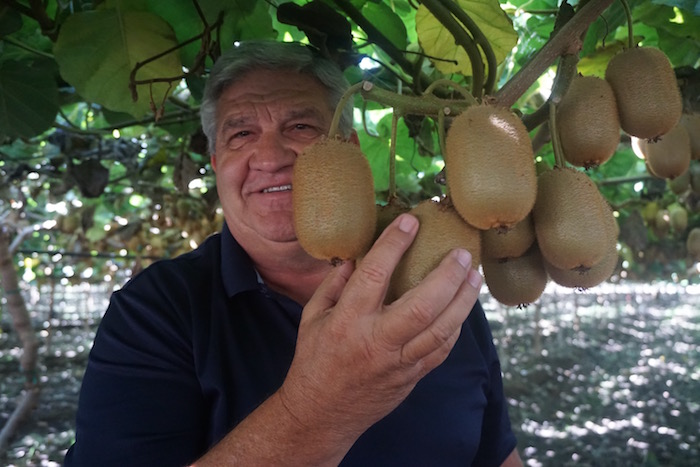
Reedley farmer Jerry Kliewer farms 128 acres of kiwis, growing the “Mega Kiwi” variety that he said maintains its sweetness along with its abnormally large size. Photo by Edward Smith
Written by
Increased acreage, new varieties and focused marketing efforts from growers may mean a big future for a little fruit.
While the kiwifruit may not have made it onto the top-20 highest valued commodities in the Central Valley according to 2017 crop reports from Tulare, Fresno, Kings and Madera counties, growers are investing more into the vine-grown treat that is native to China.
Last year, acreage in Fresno County increased three-fold over 2016 to 1,560 acres from 587, according to the ag commissioner’s office. While still paltry compared to cash crops like almonds or grapes, this is the first time Fresno County kiwi acreage exceeded 1,000 acres since the fruit’s first appearance in the crop report in 1984. It appeared for the first time in Tulare County in 1979.
The ‘Cutie’s’ treatment
Sources say that jump in acreage is due in large part to fruit marketing firm Sun Pacific, which is now branding kiwis as “Mighties,” similar to “Cuties,” the mandarins the company also sells that took the fresh fruit industry by storm. Sun Pacific declined an interview request.
In a marketing video on its website, Pasadena-based Sun Pacific, which maintains a regional office in Exeter, said it owns 50 percent of North America’s kiwi supply. It plans to triple that figure by 2025. Since “Mighties” were introduced in 2014, sales have experienced “double-digit growth,” according to the video.
At the same time, a grower in Reedley, Jerry Kliewer, is also increasing his acreage, transforming a field of plums to kiwis. It was Kliewer’s father who was one of the first growers to make a go of the fruit back in 1973.
Of the 450 acres on Kliewer Farms, 128 acres are dedicated to kiwis.
“It’s a big part of what we do,” Kliewer said.
Premium price
A number of factors have lead to the rise to growers investing in the fruit.
When growers first got into kiwis, it was a specialty fruit, which meant it could bring in typically higher premiums, according to Nick Matteis, assistant manager with the Kiwifruit Administrative Committee in Sacramento. But in the 1990s, kiwi growers had to deal with global competition. Italy and Chile, namely, increased acreage and production, with the higher volume bringing down prices until the mid-2000s when production leveled.
“The folks that are still in the game, they weathered the storm of the ‘90s of the commoditization of kiwi when the prices came down,” Matteis said. “They became better growers.”
Even today, California is still only in the top-10 of kiwifruit producers worldwide. Italy, Chile and New Zealand are the three biggest growers.
But, within the last four or five years, Matteis says, you’re starting to see new investments in the fruit.
Consumer demand
With the rise in more health-conscious consumers, kiwis grew more popular. Blueberries, kale and quinoa have skyrocketed in demand due to their marketing as so-called “super-foods.”
Packed with antioxidants like Vitamin C and folic acid, the fruit also ranks low on the glycemic index, making it attractive to insulin-sensitive consumers, Matteis said.
“Health benefits being bigger than ever, this fruit fits into that category as one of the best things you can eat per serving,” he said.
The fruit also has a wide range of varieties. It has two main types, green and gold, but there are other options as well.
“Everything from red to purple, every hue of color you can imagine there seems to be a kiwi that can fit into that profile,” Matteis said.
Though some are harder to find than others.
One new variety is the Mega Kiwi, a green kiwi to which Kliewer has exclusive rights. The fruit can be 40-50 percent larger than the Hayward Kiwi, which is the variety most shoppers will find in grocery aisles. The strain comes from Greece, where growers selectively bred kiwis looking for larger, more vigorous qualities. Kliewer brought sticks over and grafted them onto his existing Hayward vines. It takes about three years for the vines to start producing, and when they did, he noticed the fruit was big and of “exceptional quality,” he said.
He took tissue cultures and cloned it over the course of nine years, and this year will be the first year it will be harvested from its own plants.
A long road
The kiwifruit took some trial-and-error to adapt to the Mediterranean climate in the Central Valley. It started out in China, and enjoys a bit more humidity along with a cooler climate, especially the Mega Kiwi.
“We’ve had a little bit of a learning curve, but I think we’re figuring most of these things out,” Kliewer said.
It can take $20,000-$25,000 an acre just for the infrastructure, trellis’ and shade cloth necessary to get the vines to produce.
In Fresno County, growers grossed 82 percent more value from their acreage in 2017 compared to 2016, according to crop reports. In 2017, a ton of kiwis averaged $2,321 versus $1,273 in 2016. Tulare County saw an 85-percent dip in pricing from 2017 to 2016, grossing $961 per ton versus $1,780. This resulted in a total value of $25.69 million in 2017, compared to $45.75 million in 2016.
About 70-75 percent of the crop is distributed domestically, but compared to the rest of the world, Americans are eating far fewer kiwis.
“The per capita consumption in the United States is a fraction of what it is in other countries,” said Kliewer. “The consumption is probably nine times what it is here in the United States. There’s a lot of market that can be developed as soon as people learn what a great story the kiwi has.”








